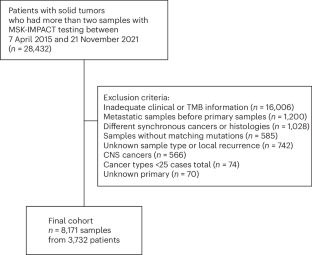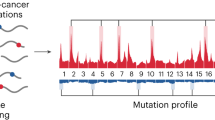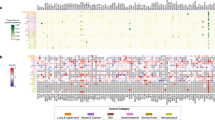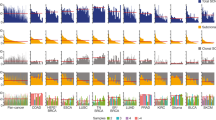Abstract
To understand genetic evolution in cancer during metastasis, we analyzed genomic profiles of 3,732 cancer patients in whom several tumor sites were longitudinally biopsied. During distant metastasis, tumors were observed to accumulate copy number alterations (CNAs) to a much greater degree than mutations. In particular, the development of whole genome duplication was a common event during metastasis, emerging de novo in 28% of patients. Loss of 9p (including CDKN2A) developed during metastasis in 11% of patients. To a lesser degree, mutations and allelic loss in human leukocyte antigen class I and other genes associated with antigen presentation also emerged. Increasing CNA, but not increasing mutational load, was associated with immune evasion in patients treated with immunotherapy. Taken together, these data suggest that CNA, rather than mutational accumulation, is enriched during cancer metastasis, perhaps due to a more favorable balance of enhanced cellular fitness versus immunogenicity.
This is a preview of subscription content, access via your institution
Access options
Access Nature and 54 other Nature Portfolio journals
Get Nature+, our best-value online-access subscription
27,99 € / 30 days
cancel any time
Subscribe to this journal
Receive 12 print issues and online access
209,00 € per year
only 17,42 € per issue
Buy this article
- Purchase on SpringerLink
- Instant access to full article PDF
Prices may be subject to local taxes which are calculated during checkout





Similar content being viewed by others
Data availability
A deidentified dataset containing the clinical features and processed data that underlie the results reported in this article derived from MSK-IMPACT tumor sequencing is available via Zenodo at https://zenodo.org/records/14538739 (ref. 55). The original sequencing reads cannot be publicly deposited due to privacy restrictions since sequencing was performed as part of clinical care.
Code availability
References
Birkbak, N. J. & McGranahan, N. Cancer genome evolutionary trajectories in metastasis. Cancer Cell 37, 8–19 (2020).
Rauwerdink, D. J. W. et al. Mixed response to immunotherapy in patients with metastatic melanoma. Ann. Surg. Oncol. 27, 3488–3497 (2020).
Morinaga, T. et al. Mixed response to cancer immunotherapy is driven by intratumor heterogeneity and differential interlesion immune infiltration. Cancer Res. Commun. 2, 739–753 (2022).
van Dijk, E. et al. Chromosomal copy number heterogeneity predicts survival rates across cancers. Nat. Commun. 12, 3188 (2021).
Valero, C. et al. The association between tumor mutational burden and prognosis is dependent on treatment context. Nat. Genet. 53, 11–15 (2021).
Liu, L. et al. Combination of TMB and CNA stratifies prognostic and predictive responses to immunotherapy across metastatic cancer. Clin. Cancer Res. 25, 7413–7423 (2019).
Davoli, T., Uno, H., Wooten, E. C. & Elledge, S. J. Tumor aneuploidy correlates with markers of immune evasion and with reduced response to immunotherapy. Science 355, eaaf8399 (2017).
Spurr, L. F., Weichselbaum, R. R. & Pitroda, S. P. Tumor aneuploidy predicts survival following immunotherapy across multiple cancers. Nat. Genet. 54, 1782–1785 (2022).
Rizvi, N. A. et al. Mutational landscape determines sensitivity to PD-1 blockade in non-small cell lung cancer. Science 348, 124–128 (2015).
Marcus, L. et al. FDA approval summary: Pembrolizumab for the treatment of tumor mutational burden-high solid tumors. Clin. Cancer Res. 27, 4685–4689 (2021).
Hieronymus, H. et al. Tumor copy number alteration burden is a pan-cancer prognostic factor associated with recurrence and death. eLife 7, e37294 (2018).
Gupta, G. P. & Massagué, J. Cancer metastasis: building a framework. Cell 127, 679–695 (2006).
Zhang, Y., Chen, F. & Creighton, C. J. Pan-cancer molecular subtypes of metastasis reveal distinct and evolving transcriptional programs. Cell Rep. Med 4, 100932 (2023).
van de Haar, J. et al. Limited evolution of the actionable metastatic cancer genome under therapeutic pressure. Nat. Med. 27, 1553–1563 (2021).
Brastianos, P. K. et al. Genomic characterization of brain metastases reveals branched evolution and potential therapeutic targets. Cancer Discov. 5, 1164–1177 (2015).
Turajlic, S. et al. Tracking cancer evolution reveals constrained routes to metastases: TRACERx Renal. Cell 173, 581–594.e12 (2018).
Yates, L. R. et al. Genomic evolution of breast cancer metastasis and relapse. Cancer Cell 32, 169–184.e7 (2017).
Cheng, D. T. et al. Memorial Sloan Kettering-integrated mutation profiling of actionable cancer targets (MSK-IMPACT): a hybridization capture-based next-generation sequencing clinical assay for solid tumor molecular oncology. J. Mol. Diagnostics 17, 251–264 (2015).
Sansregret, L. & Swanton, C. The role of aneuploidy in cancer evolution. Cold Spring Harbor Perspect. Med. 7, a028373 (2017).
Andor, N. et al. Pan-cancer analysis of the extent and consequences of intratumor heterogeneity. Nat. Med. 22, 105–113 (2016).
Mroz, E. A., Tward, A. M., Hammon, R. J., Ren, Y. & Rocco, J. W. Intra-tumor genetic heterogeneity and mortality in head and neck cancer: analysis of data from the cancer genome atlas. PLoS Med. 12, e1001844 (2015).
Bakhoum, S. F. et al. Chromosomal instability drives metastasis through a cytosolic DNA response. Nature 553, 467–472 (2018).
Gao, C. et al. Chromosome instability drives phenotypic switching to metastasis. Proc. Natl Acad. Sci. USA 113, 14793–14798 (2016).
MacKenzie, K. J. et al. CGAS surveillance of micronuclei links genome instability to innate immunity. Nature 548, 461–465 (2017).
Bielski, C. M. et al. Genome doubling shapes the evolution and prognosis of advanced cancers. Nat. Genet. 50, 1189–1195 (2018).
Robinson, D. R. et al. Integrative clinical genomics of metastatic cancer. Nature 548, 297–303 (2017).
Powell, E., Piwnica-Worms, D. & Piwnica-Worms, H. Contribution of p53 to metastasis. Cancer Discov. 4, 405–414 (2014).
Priestley, P. et al. Pan-cancer whole-genome analyses of metastatic solid tumours. Nature 575, 210–216 (2019).
Nguyen, B. et al. Genomic characterization of metastatic patterns from prospective clinical sequencing of 25,000 patients. Cell 185, 563–575.e11 (2022).
Jamaspishvili, T. et al. Clinical implications of PTEN loss in prostate cancer. Nat. Rev. Urol. 15, 222–234 (2018).
van Dessel, L. F. et al. The genomic landscape of metastatic castration-resistant prostate cancers reveals multiple distinct genotypes with potential clinical impact. Nat. Commun. 10, 5251 (2019).
Toy, W. et al. ESR1 ligand-binding ___domain mutations in hormone-resistant breast cancer. Nat. Genet. 45, 1439–1445 (2013).
McGranahan, N. et al. Allele-Specific HLA Loss and immune escape in lung cancer evolution. Cell 171, 1259–1271.e11 (2017).
Taylor, A. M. et al. Genomic and functional approaches to understanding cancer aneuploidy. Cancer Cell 33, 676–689.e3 (2018).
Turajlic, S. & Swanton, C. Metastasis as an evolutionary process. Science 352, 169–175 (2016).
William, W. Jr et al. Immune evasion in HPV—head and neck precancer-cancer transition is driven by an aneuploid switch involving chromosome 9p loss. Proc. Acad. Natl Sci. USA 118, e2022655118 (2021).
López, S. et al. Interplay between whole genome doubling and the accumulation of deleterious alterations in cancer evolution. Nat. Genet. 52, 283–293 (2020).
Alfieri, F., Caravagna, G. & Schaefer, M. H. Cancer genomes tolerate deleterious coding mutations through somatic copy number amplifications of wild-type regions. Nat. Commun. 14, 4423 (2023).
Samstein, R. M. et al. Tumor mutational load predicts survival after immunotherapy across multiple cancer types. Nat. Genet. 51, 202–206 (2019).
Shen, R. & Seshan, V. E. FACETS: Allele-specific copy number and clonal heterogeneity analysis tool for high-throughput DNA sequencing. Nucleic Acids Res. 44, e131 (2016).
Chowell, D. et al. Improved prediction of immune checkpoint blockade efficacy across multiple cancer types. Nat. Biotechnol. 40, 499–506 (2022).
Bates, D., Mächler, M., Bolker, B. & Walker, S. Fitting linear mixed-effects models using lme4. J. Stat. Softw. 67, 1–48 (2015).
Benjamini, Y. & Hochberg, Y. Controlling the false discovery rate: a practical and powerful approach to multiple testing. J. R. Stat. Soc. B (Method) 57, 289–300 (1995).
Therneau, T. Survival analysis: a package for survival analysis in R. R package version 3.8-3 https://cran.r-project.org/web/packages/survival/citation.html (2023).
Boyes R. Forester: an R package for creating publication-ready forest plots. R package version 0.5.0 https://github.com/rdboyes/forester (2021).
Kato, S. et al. Multicenter experience with large panel next-generation sequencing in patients with advanced solid cancers in Japan. Jpn J. Clin. Oncol. 49, 174–182 (2019).
Hong, T. H. et al. Clinical advantage of targeted sequencing for unbiased tumor mutational burden estimation in samples with low tumor purity. J. Immunother. Cancer 8, e001199 (2020).
Burdett, N. L. et al. Timing of whole genome duplication is associated with tumor-specific MHC-II depletion in serous ovarian cancer. Nat. Commun. 15, 6069 (2024).
Schoenfeld, A. J. et al. Clinical and molecular correlates of PD-L1 expression in patients with lung adenocarcinomas. Ann. Oncol. 31, 599–608 (2020).
Lozac’hmeur, A. et al. Detecting HLA loss of heterozygosity within a standard diagnostic sequencing workflow for prognostic and therapeutic opportunities. NPJ Precis. Oncol. 8, 174 (2024).
Shin, H. T. et al. Prevalence and detection of low-allele-fraction variants in clinical cancer samples. Nat. Commun. 8, 1377 (2017).
Fan, X., Luo, G. & Huang, Y. S. Accucopy: accurate and fast inference of allele-specific copy number alterations from low-coverage low-purity tumor sequencing data. BMC Bioinf. 22, 23 (2021).
Lin, A. L. et al. Genome-wide loss of heterozygosity predicts aggressive, treatment-refractory behavior in pituitary neuroendocrine tumors. Acta Neuropathol. 147, 85 (2024).
Clinton, T. N. et al. Genomic heterogeneity as a barrier to precision oncology in urothelial cancer. Cell Rep. 41, 111859 (2022).
Zhao, K. Paired primary and metastatic samples. Zenodo https://doi.org/10.5281/zenodo.14538738 (2024).
Acknowledgements
We are grateful to our patients and their families for their bravery and support of cancer research. We thank members of the Morris laboratory and the Center for Molecular Oncology at MSK for illuminating discussions. This study was supported by the Department of Defense Peer Reviewed Cancer Research Program and Rare Cancer Research Program, The Geoffrey Beene Cancer Research Center, Cycle for Survival: Team Fearless4Jen, The Jayme Flowers Fund, The Larry De Shon Fund, The Raquel and Riccardo Di Capua Fund, The Geri Herbert and David Yasenak Fund (to L.G.T.M.), the Weill Cornell CTSC Grant 2UL1-TR-002384 (to K.Z.), the Area of Concentration Program at Weill Cornell Medical College (to K.Z.), and the NIH/NCI Cancer Center Support Grant P30 CA008748 (institutional, to MSKCC). The funders had no role in study design, data collection and analysis, decision to publish or preparation of the paper.
Author information
Authors and Affiliations
Contributions
K.Z., J.V., C.Y.H., X.K.Z. and L.G.T.M. conceived and designed the study. K.Z., J.V., S.L., L.A.B., D.M., C.Y.H., C.V., M.L., C.F., A.S.L., M.P., S.J., X.D., T.A.C., M.F.B., X.K.Z. and L.G.T.M. acquired, analyzed and interpreted the data. K.Z., J.V., X.K.Z. and L.G.T.M. drafted the paper. All authors carried out a critical revision of the paper for important intellectual content. K.Z., J.V., X.K.Z. and L.G.T.M. carried out the statistical analysis. L.G.T.M. obtained the funding. L.A.B. provided administrative, technical or material support. C.B., X.K.Z. and L.G.T.M. supervised the study.
Corresponding author
Ethics declarations
Competing interests
M.F.B. reports personal fees from AstraZeneca and Paige.AI; research support from Boundless Bio; and intellectual property rights with SOPHiA Genetics. T.A.C. acknowledges grant funding from Bristol Myers Squibb, AstraZeneca, Illumina, Pfizer, AN2H and Eisai, has served as an advisor for Bristol Myers Squibb, Illumina, Eisai and AN2H, holds equity in AN2H and is a cofounder of Gritstone Oncology and holds equity in the company. T.A.C. and L.G.T.M. are listed inventors on intellectual property held by Memorial Sloan Kettering Cancer Center, unrelated to this work. The other authors declare no competing interests.
Peer review
Peer review information
Nature Genetics thanks Francisco Martínez Jiménez and the other, anonymous, reviewer(s) for their contribution to the peer review of this work. Peer reviewer reports are available.
Additional information
Publisher’s note Springer Nature remains neutral with regard to jurisdictional claims in published maps and institutional affiliations.
Extended data
Extended Data Fig. 1 Correlation between tumor mutational burden and fraction of genome altered.
Spearman’s rho of log2(TMB + 1) and FGA. TMB = tumor mutational burden. FGA = fraction of genome altered.
Extended Data Fig. 2 Mixed effects model results in original dataset and dataset with more stringent mutation matching criteria.
Comparison of forest plots in original dataset (a, c) to dataset with more stringent mutation matching criteria (b, d; see Methods).
Extended Data Fig. 3 De novo analyses results in original dataset and dataset with more stringent mutation matching criteria.
Comparison of de novo mutation analyses in original dataset (a, c) to dataset with more stringent mutation matching criteria (b, d; see Methods).
Extended Data Fig. 4 Mixed effects model results with different minimum purity requirements.
Estimate of TMB (a) and FGA (b) metastasis estimate from mixed effects models run with increasing minimum purity requirements. TMB = tumor mutational burden. FGA = fraction of genome altered.
Extended Data Fig. 5 Estimated effect of metastatic sample on tumor mutational burden and fraction of genome altered by cancer subtype.
(a, b) Subtype analysis of infiltrating ductal carcinoma, and the estimated effect of metastatic sample on TMB and FGA. HR = hormone receptor. (c, d) Subtype analysis of pancreatic cancer, and the estimated effect of metastatic sample on TMB and FGA. NET = neuroendocrine tumor. (e, f) Subtype analysis of non-small cell lung cancer, and the estimated effect of metastatic sample on TMB and FGA. The plots show the point estimate (dot), with the whiskers representing the 95% confidence interval. FGA = fraction of genome altered.
Extended Data Fig. 6 Tumor mutational burden and fraction of genome altered changes by quantile.
The ratio of Metastasis > Primary to Metastasis < Primary cases, alongside the mean difference in TMB (a) and FGA (b) for each quartile of primary tumor scores. Mixed effects model results for the patients in the lowest (first quartile) of TMB and FGA values for their first available sample (c, e) and in the highest (fourth quartile) of TMB and FGA values for their first available sample (d, f). TMB = tumor mutational burden. FGA = fraction of genome altered.
Extended Data Fig. 7 Association of tumor mutational burden and fraction of genome altered with overall survival, progression free survival, and immunotherapy response.
Forest plots depicting multivariable regression models examining associations with overall survival in Cox multivariable regression (a), progression-free survival in Cox multivariable regression (b), and tumor response to immunotherapy in logistic regression (c). Covariates in the models included tumor mutational burden (TMB), fraction of genome altered (FGA), cancer stage, and cancer type. Hazard or odds ratios with 95% confidence intervals and corresponding p-values are shown on the right.
Extended Data Fig. 8 De novo development of different genetic alterations between paired primary and metastatic sites by cancer type.
Percentage of patients with paired primary and metastatic samples demonstrating de novo mutations in antigen presenting mechanism (APM) genes, including B2M, TAP1, TAP2, HLA-A, HLA-B, and HLA-C. All samples were filtered to ensure a sample purity of greater than 20%.
Extended Data Fig. 9 Clonality status between paired primary and metastatic samples.
(a) Scatterplot showing paired mutations that appeared in both a primary sample and a metastatic sample from the same patient. Cancer cell fraction (CCF) of the mutation in the primary sample was plotted against CCF of the mutation in the metastatic sample. (b) Alluvial plot showing fate of cancer cell fraction (CCF) of mutations among patients with both a primary and a metastatic site sampled. This plot tracks how the clonality status, determined by CCF, changes in the metastatic site. Ind = indeterminate.
Extended Data Fig. 10 Relationship between fraction of genome with loss of heterozygosity and HLA-I loss of heterozygosity status.
The difference in fraction of genome with loss of heterozygosity (FGLOH) between paired primary and metastatic samples (a) and paired initial and subsequent primary samples (b) in different subgroups based on de novo HLA-I LOH status.
Supplementary information
Supplementary Tables 1–6
Supplementary Table 1, Patient and sample characteristics in the whole cohort and by sample type. Supplementary Table 2, Mixed effects model results at different purity cutoffs. Red shading indicates that P value is <0.05. Supplementary Table 3, Number of samples by cancer type and metastatic sample site (Fig. 4). Supplementary Table 4, Results of analysis of de novo WGD at different purity stringency cutoffs. Supplementary Table 5, Results of analysis of de novo mutations and alterations at different purity stringency cutoffs. Supplementary Table 6, Results of analysis of de novo HLA-I LOH at different LOHHLA significance thresholds.
Rights and permissions
Springer Nature or its licensor (e.g. a society or other partner) holds exclusive rights to this article under a publishing agreement with the author(s) or other rightsholder(s); author self-archiving of the accepted manuscript version of this article is solely governed by the terms of such publishing agreement and applicable law.
About this article
Cite this article
Zhao, K., Vos, J., Lam, S. et al. Longitudinal and multisite sampling reveals mutational and copy number evolution in tumors during metastatic dissemination. Nat Genet 57, 1504–1511 (2025). https://doi.org/10.1038/s41588-025-02204-3
Received:
Accepted:
Published:
Issue Date:
DOI: https://doi.org/10.1038/s41588-025-02204-3



